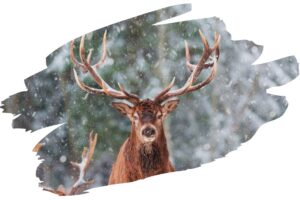Elk Facts - The Lowdown
| Range | Found in western and northern North America, as well as parts of Asia |
| Habitats | Forests, mountainous regions, meadows, grasslands |
| Diet | Herbivore that grazes on grasses, sedges, shrubs, and woody vegetation |
| Size | Shoulder height: 4 – 5 ft, Weight: 325 – 1,100 lbs |
| Life span | 10 – 13 years in wild & up to 20 years in captivity |
| Predators | Gray wolves, bears, mountain lions |
Elk Facts Video Transcription
Welcome back to another episode of Beast Bits where we’re about to charge through 10 incredible Elk facts. From their massive tines to their top speeds, elk are truly astonishing animals. And this episode of Beast bits will have you bulging with excitement over elk awesomeness.

So yes, in today’s episode of Beast Bits, we’re taking a closer look at one of nature’s most spectacular beasts – the elk. Known for their imposing size, lightning speed, and glorious antlers, elk have captivated humans for centuries.
But these iconic animals have some lesser known traits and talents that make them even more extraordinary. So get ready to have your mind blown, as we gallop through 10 amazing Elk facts.
The hoof raising revelations about elk abilities coming up, will give you a deep appreciation for these majestic creatures.
Fact number one
First off let’s talk about these iconic elk antlers male elk called bulls grow huge sets of antlers every single year that can span over 4 ft wide and weigh a staggering 40 pounds or more.
Can you imagine lugging that kind of headgear around? Talk about a literal headache.
The antlers start as little nubs in the spring then expand rapidly over the summer growing up to an inch per day during peak growth. By Fall they finish growing into these awe inspiring appendages.
Elk antlers have points called tines, and the more tines, the older and more dominant the bull is. Some elk can have up to 12 points on each antler. Now that’s a lot of tines to polish!
Fact number two
So what do male elk use these massive antlers for? Well during mating season, bull elk rub them on trees and shrubs to spread their scent, and also thrash them against vegetation, to make lots of noise saying “hey ladies look at me”.
They’re kind of like overgrown teenagers showing off their ride to impress someone they have a crush on.
Bull elk also lock antlers while dueling each other to establish dominance and claim females during the rut. These antler wrestling matches look intense as the bulls push and twist with all their might, but have no fear, they usually don’t hurt each other seriously. It’s mostly just a show of power.
Fact number three
And now on to the ladies. Female elk are known as cows and they make pretty adorable calves. Newborn elk enter the world fully developed. They can stand up and walk steadily within 30 minutes of birth. Those spindly little legs have no problem scurrying to keep up with the herd right away.
Talk about an action-packed first day of life. Makes me tired just thinking about it!
Fact number four
Elk having an incredible sense of smell, that allows them to detect predators from over one mile away.
They use their nose to sniff out threats, food, and even other elk. An elk’s giant nasal cavity is lined with hundreds of sensitive scent receptors. They can pick up the faintest odour we wouldn’t even notice
Elk have sent glands on their legs to send chemical signals and communicate with the herd. Their nose is like an an essential tool for survival.
Fact number five
So all that antler growth requires a nutrient-dense diet, which Elk get from grazing on grasses, plants, leaves, twigs and bark
An adult elk can chow down over 10 pounds of food per day. They true eating machines.
Using their specialized teeth, including incisors that work like pruning shears, elk trim and gobble up foliage with incredible speed and efficiency.
If you see freshly nibbled vegetation in areas like Montana or Wyoming, there’s a good chance that an elk was there satisfying its beastly appetite.
Fact number six
Elk must stay constantly alert for dangers with predators like wolves and bears around. So they have excellent senses adapted for detection. Their huge ears can rotate almost 360° to pick up even the faintest sounds from any direction.
With such precise hearing it’s nearly impossible to sneak up on an elk.
Fact number seven
Elk and other deer species are well equipped to handle very cold winters in their habitat. As cold weather sets in, elk grow a thicker winter coat to insulate heat. Their hollow fur even traps air for extra coziness.
Elk mostly stick to wooded areas in winter, where they are sheltered from the elements as much as they possibly can be.
If you see elk in an open field during winter, that likely means food is scarce in the woods, and they’re risking exposure to find some food.
Fact number eight
Now let’s pick up the pace and talk elk speed These bulky beasts can reach speeds of up to 45 mph when running. At full throttle seeing a giant 700 plus pound Elk Galloping at these speeds, is quite the spectacle. Makes my little jog around the block seem kind of sad in comparison.
This lightning Pace helps elk quickly escape predators, or catch up with their herd if they get separated. Pretty impressive moves for such hulking animals.
Fact number nine
Elk aren’t just fast movers, they’re also very vocal creatures.
Using sounds to communicate and warn of danger, male elk let out loud calls to attract female mates and Proclaim dominance, especially during the fall rut. It’s an other worldly whistling cry that can be heard up to a mile away.
Bulls also Grunt and bark and whistle aggressively at each other to establish hierarchy.
Picture giant elk screaming insults back and forth. It gets very rowdy.
Meanwhile female elk make lighter mews chirps and squalls to find their calves, or signal alarm.
Elk vocabulary is no joke!
Fact number 10
Let’s wrap up with with one of the most amazing elk adaptations – their specialized teeth. Elk have precisely configured chompers to match their plant based diet.
They have rigid premolar and molars in the back for grinding up vegetation, while the front incisors work like shears to grab and cut foliage. The top and bottom teeth align for maximum shredding efficiency, almost like Nature’s wire cutters.
This allows elk to demolish and digest rough woody food other animals can’t handle. They’re nifty teeth help Elks thrive in the harsh Landscapes.
Elk Facts – Wrap Up!
Well I don’t know about you, but I’m thoroughly impressed by the spectacular elk. From massive antlers to blazing speed to intriguing communication, elk are truly a marvel of nature.
I hope you’ve enjoyed galloping through these wild elk facts.
Learning about elk abilities gives us a deep admiration for their adaptability and prowess.
What elk trait impressed you the most? Let me know in the comments and don’t forget to subscribe so you never miss another exciting episodes of Beast Bits.
And always remember, keep exploring and stay curious.
Mark Evans
I sincerely hope you enjoyed that Elk facts video!
Please do show our YouTube channel some love by liking the video and subscribing to our channel.
It helps us share about these amazing animals to so many more people.
